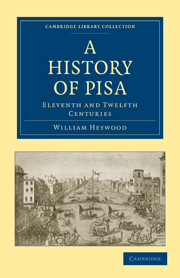Book contents
- Frontmatter
- BIOGRAPHICAL NOTE
- PREFACE
- Contents
- LIST OF PLATES
- I A FLOATING REPUBLIC
- II THE EXPULSION OF MOGAHID FROM SARDINIA
- III THE EXPEDITIONS AGAINST PALERMO AND MEHDIA
- IV THE FIRST CRUSADE
- V THE BALEARIC EXPEDITION
- VI WAR WITH GENOA
- VII THE WAR WITH THE NORMANS
- VIII INTO THE VORTEX
- IX PISAN COLONIES
- X FREDERICK BARBAROSSA
- XI EXPULSION OF THE GENOESE FROM CONSTANTINOPLE
- XII BARISONE OF ARBOREA
- XIII RAINALD OF COLOGNE
- XIV GENOA AND LUCCA AGAINST PISA
- XV CHRISTIAN OF MAYENCE
- XVI THE COMMUNES DEPRIVED OF THEIR CONTADI
- XVII PISA AND THE EMPEROR HENRY VI
- XVIII ‘THE GREAT REFUSAL’
- XIX PISA UNDER THE GOVERNMENT OF THE CONSULS
- XX CONSORTERIE GENTILIZIE
- XXI FROM CONSULS TO POTESTA
- BIBLIOGRAPHICAL APPENDIX
- INDEX
- Plate section
XX - CONSORTERIE GENTILIZIE
Published online by Cambridge University Press: 05 July 2011
- Frontmatter
- BIOGRAPHICAL NOTE
- PREFACE
- Contents
- LIST OF PLATES
- I A FLOATING REPUBLIC
- II THE EXPULSION OF MOGAHID FROM SARDINIA
- III THE EXPEDITIONS AGAINST PALERMO AND MEHDIA
- IV THE FIRST CRUSADE
- V THE BALEARIC EXPEDITION
- VI WAR WITH GENOA
- VII THE WAR WITH THE NORMANS
- VIII INTO THE VORTEX
- IX PISAN COLONIES
- X FREDERICK BARBAROSSA
- XI EXPULSION OF THE GENOESE FROM CONSTANTINOPLE
- XII BARISONE OF ARBOREA
- XIII RAINALD OF COLOGNE
- XIV GENOA AND LUCCA AGAINST PISA
- XV CHRISTIAN OF MAYENCE
- XVI THE COMMUNES DEPRIVED OF THEIR CONTADI
- XVII PISA AND THE EMPEROR HENRY VI
- XVIII ‘THE GREAT REFUSAL’
- XIX PISA UNDER THE GOVERNMENT OF THE CONSULS
- XX CONSORTERIE GENTILIZIE
- XXI FROM CONSULS TO POTESTA
- BIBLIOGRAPHICAL APPENDIX
- INDEX
- Plate section
Summary
During the latter half of the twelfth century the Italian cities exercised a marked centripetal attraction on the inhabitants of the country districts, though, in a large number of cases, the motive power, in so far as it affected the feudal seigniors, was nothing better than naked compulsion. Assailed by the citizens, they were forced to swear submission to the civic magistrates, to build palaces in the cities and to reside there for a specified period in every year. For the vanquished, citizenship was, in fact, a concomitant of vassalage. In Pisa, on the other hand, less violent methods were generally adopted. For historical and geographical reasons, the Pisans had, as we have seen, lived on unusually amicable terms with the feudatories of their contado, seeking rather to lure than to coerce them to the service of the Commune. As a result the privileges and responsibilities of citizenship were not infrequently voluntarily assumed.
In the eleventh century the Gherardesca of the Volterran Maremma descended the valley of the Era, with slow but continual movement; they established themselves in the valley of the Arno, from Ventrignano, near S. Miniato al Tedesco, to Settimo, at the gates of Pisa, and there they intermarried with the Visconti. Over Ventrignano they exercised feudal jurisdiction, and, after it had been destroyed by Christian of Mayence, they transferred their curia to Monte Bicchieri which had been built by the fugitives, who, however, remained subject to the “placita et banna” of the counts.
- Type
- Chapter
- Information
- A History of PisaEleventh and Twelfth Centuries, pp. 252 - 261Publisher: Cambridge University PressPrint publication year: 2010First published in: 1921

